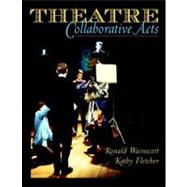
Theatre : Collaborative Acts
by Wainscott, Ronald; Fletcher, Kathy J.Buy Used
Rent Textbook
New Textbook
We're Sorry
Sold Out
eTextbook
We're Sorry
Not Available
How Marketplace Works:
- This item is offered by an independent seller and not shipped from our warehouse
- Item details like edition and cover design may differ from our description; see seller's comments before ordering.
- Sellers much confirm and ship within two business days; otherwise, the order will be cancelled and refunded.
- Marketplace purchases cannot be returned to eCampus.com. Contact the seller directly for inquiries; if no response within two days, contact customer service.
- Additional shipping costs apply to Marketplace purchases. Review shipping costs at checkout.
Summary
Table of Contents
Every chapter contains “For Further Exploration,” “Questions and Activities,” and “Key Terms and Concepts.”
ACT I. THEATRE AND ITS AUDIENCE.
1. Cultural Colaboration: Theatre and Society.
Theatre as Entertainment and Art.
The Social Functions of Theatre.
Social Control of Theatre.
Cultural Context and Personal Experience.
2. Experiencing Theatre: Collaboration of Actor, Audience, and Space.
The Audience.
The Nature of Acting.
From Play to Production.
Space.
Theatre and Transformation.
3. Analyzing Theatre: Thinking and Writing About Live Performance.
Theatre, Film, and Television.
Analyzing Production.
Thinking About Actor Performances.
Thinking About Space and Design.
Understanding Style.
Evaluating Production.
The Role of the Critic.
Writing About Production.
When It All Works.
4. Understanding the Play: A Theatrical Blueprint.
Character.
Thought.
Language.
Music.
Spectacle.
5. Interpreting the Play: Understanding Genre, Reading, and Writing.
Dramatic Genre.
Reading a Play.
Writing About a Play.
6. Producing the Play: Connecting Theatre and Audience.
Theatrical Choice in North America.
The Role of the Producer.
The Economics of Theatre.
Photo Essay: Theatrical Diversity.
ACT II. THEATRE: COLLABORATION IN HISTORY.
7. Foundations: Classical Theatrical Forms.
Classical Greece.
Classical Rome.
Classical India.
Medieval Europe.
Classical China.
Classical Japan.
8. Reinterpretations: Europe Rediscovers the Western Classics.
The Italian Renaissance.
Elizabethan England.
The Spanish Golden Age.
Seventeenth-Century France.
Restoration England.
Eighteenth-Century Europe and the Americas.
9. Revolutions: Romanticism to Postmodern.
Romanticism.
Nineteenth-Century Melodrama.
Nineteenth-Century Realism and Naturalism.
The Avant-Garde from the Late Nineteenth Century to the 1960s.
Twentieth-Century Popular Theatre.
The Recent Avant-Garde and Postmodern Experiment.
Timeline.
ACT III. COLLABORATION IN ART AND PRACTICE.
10. The Director: Vision and Leadership.
Has Someone Always Been in Charge?
Interpretation.
Developing Concept.
Communicating and Managing the Artistic Vision.
Collaborating with the Playwright.
Collaborating with Actors.
Collaborating with Stage Management.
The Rehearsal Process.
Opening the Production.
The Artistic Director.
11. The Actor: From Mask to Contemporary Performance.
Development of the Actor.
The Actor's Work.
12. The Playwright: Imagination and Expression.
The Changing Position of the Playwright.
The Playwright and Production.
Development of New Plays.
13. The Designer: Materializing Conception and the World of the Play.
The Development of the Designer.
The Designers' Choices.
Artists of the Theatre: Ming Cho Lee.
The Scenic Designer's Work.
The Lighting Designer's Work.
The Costumer Designer's Work.
The Sound Designer's Work.
Integrating All the Designs.
Photo Gallery: Interpreting Space and Design.
An electronic version of this book is available through VitalSource.
This book is viewable on PC, Mac, iPhone, iPad, iPod Touch, and most smartphones.
By purchasing, you will be able to view this book online, as well as download it, for the chosen number of days.
Digital License
You are licensing a digital product for a set duration. Durations are set forth in the product description, with "Lifetime" typically meaning five (5) years of online access and permanent download to a supported device. All licenses are non-transferable.
More details can be found here.
A downloadable version of this book is available through the eCampus Reader or compatible Adobe readers.
Applications are available on iOS, Android, PC, Mac, and Windows Mobile platforms.
Please view the compatibility matrix prior to purchase.
